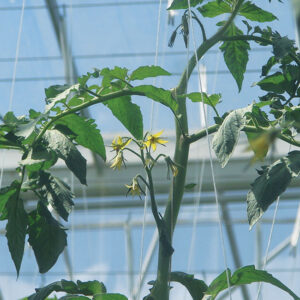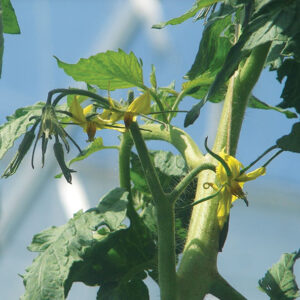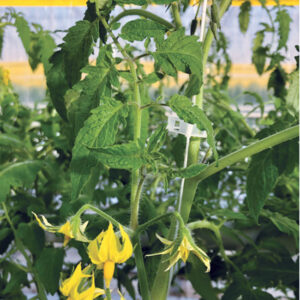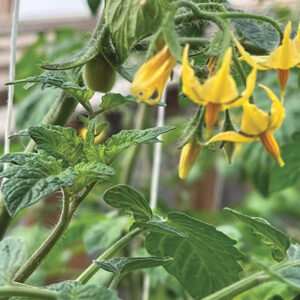
Features
Understanding tomato plant signals and making decisions for better productivity
Part 2: Clusters and flowers A continuation of the series on understanding tomato plant signals
June 5, 2023 By DR. MOHYUDDIN MIRZA
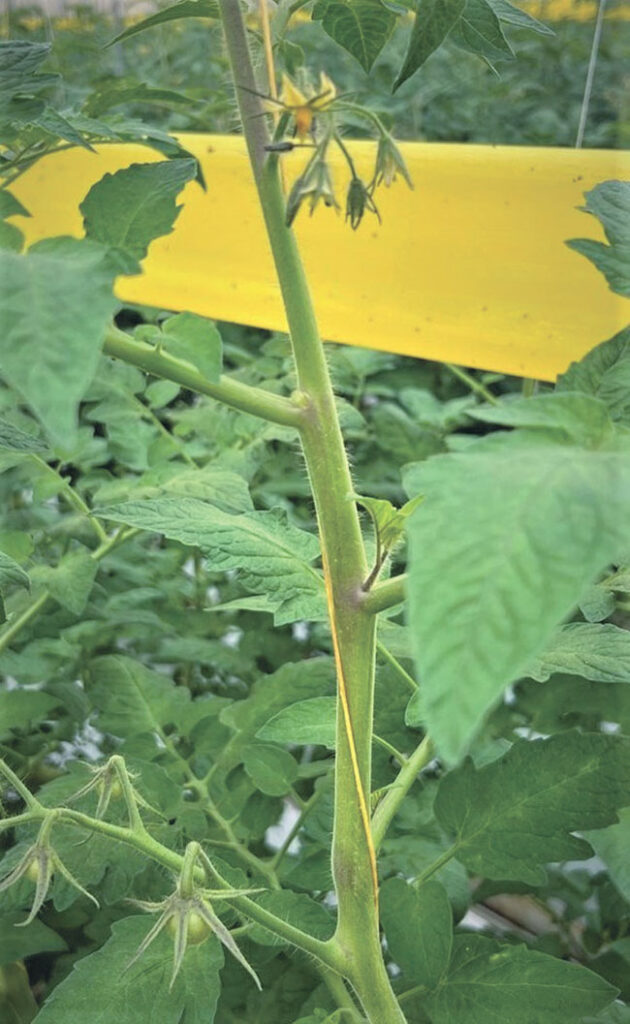 Photo 1
Photos courtesy of MOHYUDDIN MIRZA.
Photo 1
Photos courtesy of MOHYUDDIN MIRZA.
In part one of the article on tomato plant signals, it was mentioned that three leaves and one set of clusters is produced in greenhouse varieties and the speed of development depends on plant’s budget of energy produced and consumed. When a plant enters a generative state, then it channels more resources to clusters, individual flowers and fruits compared to leaves, roots and stems. All climate parameters are required to be at optimum level along with water, nutrients and other inputs. Some readers asked to include pictures from early and later stages of crop.
Picture 1 (left): Three leaves and one cluster example from a young crop with the very first cluster with fruit visible and second cluster opening up. It is worth mentioning that the shape and size of these flower cluster is pre-determined about 45 days earlier when buds were being formed and are affected by the climate conditions at that time. So, if you want to know more about these clusters then you must know what happened earlier. Temperature at the time of bud set is the biggest determining factor for cluster size, length and vigor of flowers.
Picture 2 (right): A mature crop and a cluster is seen, then two leaves and then one cluster. That can happen when plant is in a strong generative mode, good assimilates are bring formed and translocated.
About the clusters?
Shapes, angle of appearance, and length tell a lot of things. Grape tomatoes have longer clusters, sometimes double and triple branching. One grower counted 70 fruits on one cluster. Large fruited varieties have smaller length clusters compared to grapes or cocktail-type tomatoes.
Angle of cluster growth from the stem
An angle of 45 degrees, like in pictures 1 and 2, is an indication of good balance between vegetative and vegetative growth and good climate parameters, especially the proper relative humidity. Clusters that are parallel to the stem is an indication of higher relative humidity, low transpiration, rapid growth under lower light levels, and likely will “kink” when fruit is set especially in large fruited varieties.
When leaves or shoots come out of the clusters
Picture 3 (P. 30, left) shows a thick stem, big flowers and leaves coming out of the cluster. It appears that the symmetry is lost. The flowers are pale yellow with thick calyx. Any fruit set on these clusters will show “catfacing” at the blossom end due to poor pollination. This is a very vegetative signal from the plant.
Picture 4 (P. 30, middle) shows a cluster was formed and then a strong shoot emerged out of that. The leaves can appear anywhere on the cluster, sometimes at the end of the cluster as well. This shows that plant is confused as to what the grower is trying to achieve. The plant became generative and then back to vegetative likely due to set points on temperature, relative humidity, irrigation volumes, more ammonium nitrogen and some others.
Picture 5 (P.30, right) is an example of a good cluster, set at proper angle, and brown spot-on flower anthers indicating that bumble bees visited it and pollinated it. Petals bent backward to attract pollinators and after that close and senesce and fall off and fruit is visible.
In order to understand these signals, we have to go back to the basic plant cycle. When seeds germinate, they develop roots and shoots and leaves and is part of what we call vegetative state. The plant’s priority is to produce leaves and support with adequate roots so that the process of food manufacturing (photosynthesis) can be started. Tomato plants ideally produce seven to nine leaves before first cluster appears, although the buds were formed almost 45 days ago. These flower buds started forming when first set of true leaves start developing and growers use cooler temperatures to keep them from stretching.
Once the flower buds start opening, plant signal is to start generative growth. The main thing is that the tomato plant has to keep a balance between vegetative and generative growth. The management approaches for keeping the balance requires in depth knowledge of the production cycles based on the sunlight. For example, tomato life span can be divided into: winter (Nov. to Dec.); early spring (Jan. to Feb.); mid spring (Feb. to April); summer (May to July) and summer/fall (Aug. to Nov.) As an example, for the summer cycle, radiation levels can exceed 2,000 joules/cm2/day. The focus should be on the quality of the flowering truss. Target fruit loads 80+/ m2 to ensure good leaf length. Control over the plant climate is reduced and is subject to daytime extreme. Here are few strategies growers use to maintain high production:
- Adjust day and night temperatures to obtain lower 24 hours averages.
- Reduce light intensity to close to 1,500 joules by external shading and active use of screens. Very high Daily Light Integrals can reach during this production cycle and that can negatively stress the plant.
- Try to maintain CO2 levels around 800 ppm early in the morning when vents are not fully open. In summer below ambient CO2 levels can affect fruit sizing and reduced new leaf growth.
- Adjust feed EC based on light. Plants at this production cycle depend more on feed EC rather than slab EC. Adjust over drain percentage to keep the slab EC around 3.0.
- I recommend to introduce pH adjusted water under high transpiration demands when light is above 1,500 joules.
- With longer days, adjust irrigation practices and volumes so plants are not short of water. When this happens, the plants can draw water from the fruits resulting in poor quality.
- Pay particular attention to Vapor Pressure Deficit (VPD). Important to activate the plant early in the morning (VPD>3 grams/m3 of air) to condition high VPD in afternoon that can exceed 12 grams/m3.
- Target 20 to 25 leaves for transpiration under high temperatures.
- In conclusion, I want to say pay attention to all the details in each production cycle to maintain a balance between vegetative and generative growth. Good growers are consistently achieving over 80 kg/ m2.
Print this page
